Tax Reform Could Mean Big Things for Sales
By Robert Knakal March 8, 2017 9:35 am
reprints
Recessions and tax policy changes provide inflection points in our investment sales market. Tax policy, almost more than anything else, impacts the behavior of discretionary sellers of commercial real estate assets. With major tax reform looming, it is an appropriate time to look at how the market has been impacted in the past.
Interestingly, many very smart and well-respected analysts claim that tax policy does not affect the way folks do things. When it comes to Manhattan’s commercial real estate sales market, nothing could be further from the truth. In fact, since 1984, three of the top four turnover ratio (number of properties sold divided by the total stock of properties) years have been times in which tax policy has had an impact (prior to the most recent and unprecedented market rally in 2014 and 2015).
1986 was the first of these. The Tax Reform Act of 1986 significantly altered tax policy under President Ronald Reagan. This tax reform cut both ways, simultaneously helping as well as hurting the market (pain was felt by many as passive loss rules were changed which bankrupted an entire industry of investors who structured tax write-off deals for passive investors—but that is a topic for another day). The number of marginal brackets was reduced significantly and tax rates dropped. This stimulated discretionary sellers to get rid of their properties, causing a spike in turnover. This externality essentially accelerated selling decisions, “stealing” activity from 1987. If we look at the turnover ratio, we see that had 1986 not stolen activity from 1987, there would have been a smooth and steady increase year-over-year until the market’s natural cyclical peak in 1988 (the only year in the top four not stimulated by tax policy changes).
In 1998, the Clinton administration reformed tax policy including a meaningful reduction in the capital gains tax rate from 28 percent to 20 percent. Sellers flooded into the market, forcing the turnover ratio to soar to 3.9 percent, a then-record. All of this activity encouraged some investors to move to the sidelines as the market was in its sixth year of recovery at the time and values had returned to levels that many felt were not sustainable. If those investors sat out, they would have had to wait another 10 years to see values fall.
The third year of the top three in which the turnover ratio spiked based upon tax changes was 2012. A 3.8 percent increase in capital gains taxes was hidden in the Affordable Care Act (Obamacare) that was set to kick in during the 2013 tax year. 2012 was also a year in which threats of even higher capital gains taxes impacted the market. The political rhetoric coming out of Washington D.C. had many legislators indicating that tax increases, particularly in capital gains taxes, would be implemented. This caused a massive wave of selling, especially in the fourth quarter of 2012. At Massey Knakal Realty Services we closed nearly 50 percent of our annual transactions in the fourth quarter, with the majority of those being in December. In fact, we closed 23 sale transactions on New Year’s Eve that year (that remains the highest quarter in terms of total building sales the city has seen since my team has been tracking it).
The recessionary periods over the past 33 years have each played out very differently. Although the stock market crashed mightily in October 1987, the following year was very strong for Manhattan’s building sales market. So was the first half of 1989 as the market really didn’t begin to soften until late that year. The savings and loan crisis in the early 1990s was the worst downturn I have personally seen. During the Great Recession in 2008 to 2009, average property values in Manhattan dropped by 38 percent on a price-per-square-foot basis. In the early 1990s, some segments of the market fell by as much as 68 percent in value. I recall selling apartment buildings in the late 1980s for 10 to 12 times the gross rent for conversion to cooperatives (at this time, condos were things your grandparents lived in down in Florida). In 1991 to 1993 when we were selling the same buildings for their lenders, the multiples were as low as four to five times the gross rents.
The recession in the early 2000s caused by 9/11, the Russian credit crisis and the dot.com bubble bursting, was relatively benign from an investment sales perspective. Turnover ratios clearly were muted with the longest period of sub-2 percent turnover (four years) in our 33-year analysis period. However, average prices per square foot did not fall in any one of those years. Starting in 1993, values experienced a 14-year bull market through 2007.
The recent Great Recession was a whopper and, while not as bad as the early 1990s, both volume and value really took it on the chin. As stated above, values dropped by 38 percent on a price-per-square-foot basis and volume plummeted. Citywide the $62.2 billion of sales we saw in 2007, fell to just $6.2 billion by 2009, a 90 percent drop. Ouch! In Manhattan, the turnover ratio was just 1.2 percent in 2009, the lowest we have ever seen.
The Trump administration brings with it uncertainty, however, with major tax reform as a keystone of the new president’s platform, a profound change in our market could be around the corner. Similar to changes made in 1986, there are pros and cons on the horizon. It will all come down to what form that tax reform takes on and, until the details are released, it’s anyone’s guess.


